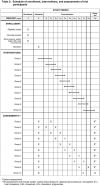Emirates Heart Health Project (EHHP): A protocol for a stepped-wedge family-cluster randomized-controlled trial of a health-coach guided diet and exercise intervention to reduce weight and cardiovascular risk in overweight and obese UAE nationals
- PMID: 37036843
- PMCID: PMC10085020
- DOI: 10.1371/journal.pone.0282502
Emirates Heart Health Project (EHHP): A protocol for a stepped-wedge family-cluster randomized-controlled trial of a health-coach guided diet and exercise intervention to reduce weight and cardiovascular risk in overweight and obese UAE nationals
Erratum in
-
Correction: Emirates Heart Health Project (EHHP): A protocol for a stepped-wedge family-cluster randomized-controlled trial of a health-coach guided diet and exercise intervention to reduce weight and cardiovascular risk in overweight and obese UAE nationals.PLoS One. 2024 Dec 9;19(12):e0315685. doi: 10.1371/journal.pone.0315685. eCollection 2024. PLoS One. 2024. PMID: 39652538 Free PMC article.
Abstract
Introduction: Cardiovascular disease (CVD) is the most common cause of death both globally and in the United Arab Emirates. Despite public health measures and health education, the rates of death from CVD remain stable. Barriers previously identified to lifestyle changes include cultural reasons, boredom, and lack of family support. The Emirates Heart Health Project (EHHP) seeks to support healthy lifestyle changes through a family-based intervention using a health coach and fitness tracker.
Methods and analysis: The EHHP is a stepped-wedge cluster-randomized trial with each cluster comprised of members of an extended family. Eligible participants will be ≥ 18 years of age, with BMI ≥ 25, have Emirati citizenship and be able to give informed consent for study participation. The cluster will have 16 weekly teaching sessions in the participants' family home by a health coach who will review individual weight, diet and exercise (monitored by a wearable fitness tracker). The clusters will have pre-intervention assessments of their weight and CVD risk profile and enter the intervention in randomized order. Each cluster will have a post-intervention assessment of the same measures. The primary outcome is weight reduction from baseline. Secondary outcomes will include change in CVD risk factors such as systolic and diastolic blood pressure, hemoglobin A1c, total cholesterol, LDL cholesterol, HDL cholesterol and triglycerides, waist circumference, and BMI. A mixed linear model will be used for analysis, where the parameters measured at the end of each 16-week episode will be the outcome values. These will be analyzed such that baseline values (measured just prior to the start of an episode) will be fixed covariables. Random effects are the family units. This trial has been registered with the NIH at clinicaltrials.gov (NCT04688684) and is being reported using the SPIRIT (Standard Protocol Items: Recommendations for Interventional Trials) and TIDieR (Template for intervention description and replication) framework.
Trial registration: Clinicaltrials.gov NCT04688684.
Copyright: © 2023 King et al. This is an open access article distributed under the terms of the Creative Commons Attribution License, which permits unrestricted use, distribution, and reproduction in any medium, provided the original author and source are credited.
Conflict of interest statement
The authors have declared that no competing interests exist.
Figures
References
-
- Burgoine T, Sarkar C, Webster CJ, Monsivais P. Examining the interaction of fast-food outlet exposure and income on diet and obesity: evidence from 51,361 UK Biobank participants. International Journal of Behavioral Nutrition and Physical Activity. 2018;15:71. Available from: 10.1186/s12966-018-0699-8 - DOI - PMC - PubMed
-
- Afshin A, Micha R, Khatibzadeh S, et al.. The impact of dietary habits and metabolic risk factors on cardiovascular and diabetes mortality in countries of the Middle East and North Africa in 2010: a comparative risk assessment analysis. BMJ Open. 2015;5:e006385. Available from: 10.1136/bmjopen-2014-006385 - DOI - PMC - PubMed
Publication types
MeSH terms
Associated data
LinkOut - more resources
Full Text Sources
Medical



